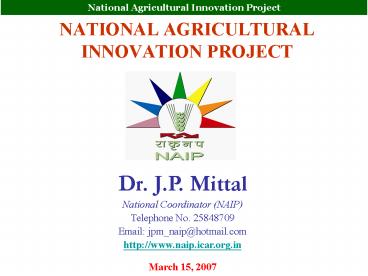NATIONAL AGRICULTURAL INNOVATION PROJECT PowerPoint PPT Presentation
1 / 14
Title: NATIONAL AGRICULTURAL INNOVATION PROJECT
1
NATIONAL AGRICULTURAL INNOVATION PROJECT
National Agricultural Innovation Project
Dr. J.P. Mittal National Coordinator
(NAIP) Telephone No. 25848709 Email
jpm_naip_at_hotmail.com http//www.naip.icar.org.in
March 15, 2007
2
BACKDROP
National Agricultural Innovation Project
- Less than half of the targeted growth in
agriculture during the 10th FYP - Farmers are in great distress
- New strategy and re-orientation in RD in
agriculture necessary to support - food nutritional security
- employment income generation
- poverty alleviation
3
National Agricultural Innovation Project
NAIP Implementation Details
- Project period 6 years
- Project Outlay Rs. 1200 crores (US 250
Million, credit US 200 million) - Project Launched on July 26, 2006
4
National Agricultural Innovation Project
NAIP Approach Methodology
- Production to consumption system, end-to-end
approach involving concerned stakeholders in
consortium mode - Sponsored and competitive funding
- Greater public-private sector partnership
- Small number of big projects
- Wide stakeholder consultations for project
development - Strong emphasis on gender and social and
environmental auditing and impact assessment
5
NAIP Approach Methodology
National Agricultural Innovation Project
- Emphasis on business development units,
Intellectual Property Rights (IPR) management,
policy analysis and visioning - Ample attention to individual Learning Capacity
Building but more attention to institutional
learning - Clear post-project synthesis and uptake planning
- Clear-cut guidelines, decentralized rules and
procedures in place before launching the project - IT-based management information system
- Focus on ME and impact assessment
- Stress on knowledge management, communication and
media strategy
6
National Agricultural Innovation System
private sector
development community
Market orientation
Poverty orientation
National Agricultural Research System
Scientific capacity
other science providers
Guiding Model NAIP pushes three frontiers
7
ICAR as the Catalyzing Agent for Management of
Change in the Indian Agricultural Research System
National Agricultural Innovation Project
- Total allocation Rs. 228 crores
- Strengthening communication ability information
capacity - Enhanced dialogue and interaction with public at
large, farming community, private sector and
within ICAR system between all key functionaries - Business development units and IPR management
- System-wide institutionalization of organization
and management reforms like ME and Financial
management - Visioning, technology foresight and policy
analysis - Emphasis on SAUs
8
Production to Consumption Systems
National Agricultural Innovation Project
- Total allocation Rs. 357 crores
- About 15 Consortia with public organizations,
private sector, farmer organizations, NGOs and
others from across the production to consumption
system - Jointly responsible for governance, design and
implementation of research programs and the
application of the resulting innovations - Knowledge management activities, such as the
organization of conferences and innovation market
places, networks and communication strategies. - Selection through a competitive process
- Support to investment, operational and some
personnel costs of the consortia
9
Examples of Possible Value Chains
National Agricultural Innovation Project
- Category Agro-processing
- Potato
- Buffalo Meat/ Fishes
- High value Soya Products
- Category Resource use efficiency
- Conservation Agriculture
- Water productivity (Multiple Use)
- Bio-fuel
- Category Income Augmentation and Employment
Generation - Sorghum in SAT
- Milk and Milk Products in Rainfed Areas
- Marine Fish
- Category Export Promotion
- Fruits viz., Mango, Grapes, Passion Fruit etc.
- Spices and Value Added Products
- High Value Fish (Tunas, Pomfrets, Crabs) in
Coastal/ Island Areas and Mariculture
10
EXAMPLE VALUE CHAIN ON MEAT AND MEAT PRODUCTS
Potential Consortium Partners
Important Aspects
Most Critical Missing Links
- Identification and estimation of pesticidal and
antibiotic residues - Packaging of meat and meat products
Consumption (Safety Quality)
IVRI, NCL, IIP
- Demand supply (domestic global) analysis
- Market intelligence
NCAP, IEG, DMI, NCAER
Marketing
NRC (Meat)/IVRI, Vety.College, Tirupati, CFTRI,
DFRL, Hind (Agro), Al-kabeer, Allanasons
- Slaughter house byproducts utilization
- Tenderization of spent animals meat
Processing
IVRI, TNVASU, BAIF
- Research on Feed supplements and micronutrients
- Research on health cover
Production
KVKs, E-chaupals, ATMAs, FOs, PRIs, VKCs, SHGs
Farmers
Processors
Traders/Exporters
Consumers
Government
11
Sustainable Rural Livelihood Security
National Agricultural Innovation Project
- Total allocation Rs. 350 crores
- Focus on 150 disadvantaged districts selected by
Planning commission on the basis of index of
backwardness - About 20 regionally based consortia
- Emphasis on participatory approaches for defining
and implementing the agenda. - Integration with the activities of rural
development projects, Agricultural Technology
Management Agencies, other State extension
initiatives and NGOs - Invited as well as a competitive grants elements
- NRM, food and nutritional security, farming
systems research
12
EXAMPLE DROUGHT PRONE/RAINFED AGRICULTURE AREAS
In-situ soil moisture conservation Drought
proofing technologies
ICAR, SAUs, CGIAR, MOEF
NGOs, Banks, MOSW, Insurance Companies
Resource scarcity and lack of self mobilisation
risk
Drought prone rainfed agriculture
Technology refinement, demonstrations in all
enterprises including post-harvest processing
structures
Private Sector, IITs, Line Deptts., APMC,
Development Banks
KVKs, ATMAs, CAPART, NGOs
Poor-adoption of appropriate package of practices
Insufficient and inefficient livelihood support
system
Under employment
Alternate land use Integrated farming systems
Production to Consumption system with emphasis on
diversification Improvement of CPRs
ICAR, SAUs, ATMA, Line Deptts., Private Sector
Only Field crops, less diversified farms
Less access to knowledge/ information
ICAR, SAUs, ATMAs
Potential Consortium Partners
Potential Consortium Partners
Interventions
Causes
Causes
Interventions
Problem
BIO-PHYSICAL PART
SOCIO-ECONOMIC PART
Interventions
13
Governance Structure for the National
Agricultural Innovation Project
National Steering Committee
Project Management Committee
Research Programme Committee
OM Programme Committee
OM Advisory Group
TAG 2
TAG 3
TAG 4
Project Implementation Unit
National Director
Procurement
Finance
Administration
National Coordinator (Livelihood-
Improvement) Component 3
National Coordinator (Value Chain) Component 2
National Co-ordinator (OM) Component 1
National Coordinator (Basic Strategic
Research) Component 4
As in Component 2
As in Component 2
Project 1
Project 2
Project N
CAC 1
CAC 2
CAC N
TAG Technical Advisory Group
CIC 1
CIC 2
CIC N
CAC Consortium Advisory Committee
Cons 1
Cons 2
Cons N
CIC Consortium Implementation Committee
14
National Agricultural Innovation Project
Thank You

